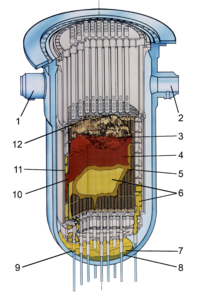
Photo from wikipedia
Abstract The weathering processes of seafloor massive sulfide (SMS) deposits would significantly change the mineralogy and geochemistry of sulfides. The key to understanding the oxidation of SMS deposits lies in… Click to show full abstract
Abstract The weathering processes of seafloor massive sulfide (SMS) deposits would significantly change the mineralogy and geochemistry of sulfides. The key to understanding the oxidation of SMS deposits lies in clarifying the metal mobilization during the oxidation of submarine sulfides by seawater and Fe-Si-rich hydrothermal fluids. We present the morphology, mineralogy, and geochemistry of secondary minerals and oxyhydroxides from the Xunmei hydrothermal field on the Southern Mid-Atlantic Ridge (SMAR) to illuminate their diverse characteristics and origins, further elaborating detailed submarine oxidation processes of sulfide mounds. Under the oxygenated seawater environments, the pyrite/marcasite and chalcopyrite were oxidized to Fe (oxyhydr)oxides and secondary Cu minerals (e.g., covellite, paratacamite/atacamite, and chalcanthite), respectively. The metal speciation in the sulfides (e.g., pyrite, marcasite, and chalcopyrite) controls the metal mobilization during oxidation. Cobalt and As in the crystal lattice of pyrite and marcasite vary over variations in Fe and S, respectively. Zinc, Ag, and Pb that occur as micron-inclusions in the pyrite, marcasite, and chalcopyrite are easily released during the galvanic interaction, of which mechanism is applicable to Cu-inclusions in the pyrite and marcasite. Compared to the enrichment of Zn and Ag in the secondary minerals via adsorption, Pb is depleted because of its high solubility in the seawater. The mineralization of amorphous oxyhydroxides includes low-temperature Si-rich precipitation and later oxidative weathering processes. The Si-rich hydrothermal fluids dissolve the basalt enriched in plagioclase and V-rich clay minerals to precipitate V-rich Si-Al oxyhydroxides. Subsequently, the flowing Si-rich hydrothermal fluids evoke precipitation of amorphous silica due to conductive cooling. As the alteration proceeds, a genetic scenario for the formation of Fe and Si oxyhydroxides is proposed. The Fe-Si-rich hydrothermal fluids alter the sulfides to Fe-Si oxyhydroxides and then Fe oxyhydroxides with an increasing trend of Fe, Cu, Zn, and Co. Our results unravel the metal mobilization during the weathering processes of submarine sulfides, establish a scenario for the formation of oxyhydroxides associated with sulfides, and predict the effect of oxidation on the economic values of sulfides.
Journal Title: Marine Geology
Year Published: 2021
Link to full text (if available)
Share on Social Media: Sign Up to like & get
recommendations!